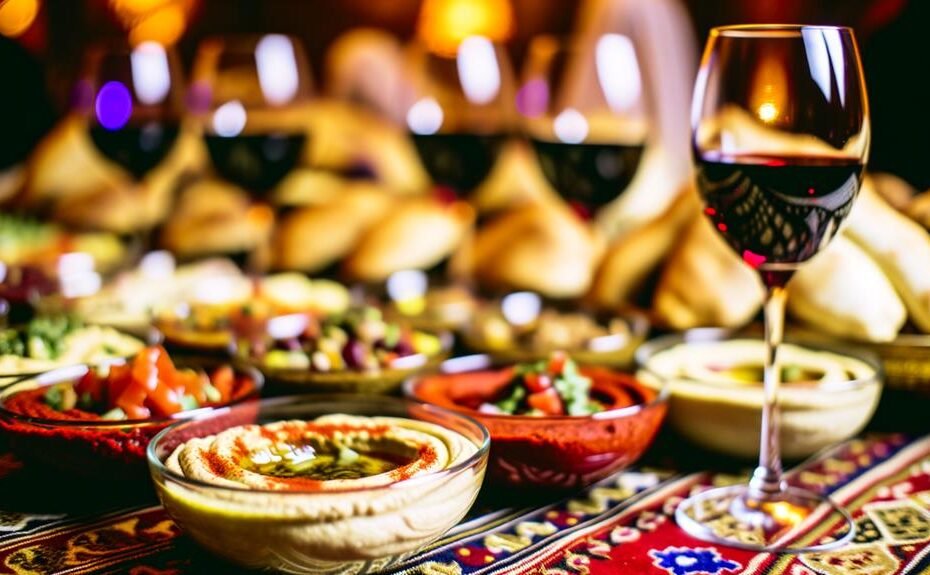Embarking on the journey of pairing wine with Middle Eastern cuisine requires an understanding of the diverse flavors and textures it offers. It's not just about finding the right wine; it's about appreciating the blend of spices and herbs that define dishes like shawarma, tabbouleh, and baklava.
By matching a bold Syrah with cumin-spiced kebabs or a crisp Sauvignon Blanc with tangy falafel, you can create a dining experience that is both elegant and complementary. These pairings are guided by essential principles that enhance the overall enjoyment of the meal.
Basic Principles
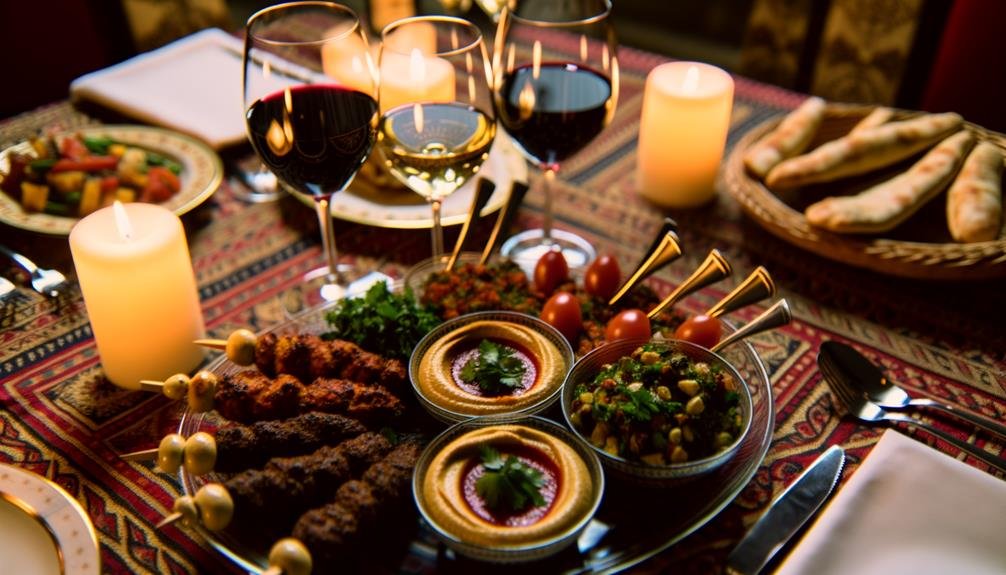
Pairing wine with Middle Eastern cuisine requires careful consideration of intensity to achieve a balanced harmony. The bold herbs and spices commonly found in Middle Eastern dishes can significantly impact wine selection. Matching the intensity ensures that neither the dish nor the wine dominates the palate.
For example, high-acidity white wines work well with dishes containing raw garlic and onion, as they help cut through the strong flavors and refresh the palate. Moreover, pairing wines with the sauces used in meat dishes can elevate the overall dining experience.
This thoughtful approach to intensity and flavor profiles is key to creating successful culinary pairings.
Classic Ingredients
When selecting wines to pair with Middle Eastern dishes, it's essential to consider the key ingredients that define their bold and flavorful profiles. Middle Eastern cuisine is known for its use of a diverse array of herbs, spices, and condiments that elevate the taste experience. These ingredients, such as parsley, cilantro, cumin, onion, garlic, lemon, and tahini, play a crucial role in shaping the dishes and influencing the wine choices.
The aromatic herbs and spices like parsley, cilantro, and cumin add layers of complexity and richness to the dishes, enhancing their overall flavors. Aromatic vegetables like onion and garlic are used generously, contributing to the savory elements of the cuisine and guiding towards wines with higher acidity to balance their intensity. Tangy condiments such as lemon and tahini bring a zesty brightness to the dishes, calling for wines that can complement and harmonize with these tangy notes.
Understanding the significance of these classic ingredients is key to creating harmonious wine pairings that elevate the dining experience. By considering the flavor profiles and characteristics of Middle Eastern dishes, you can choose wines that enhance and complement the vibrant flavors of the cuisine.
Food and Wine Pairings
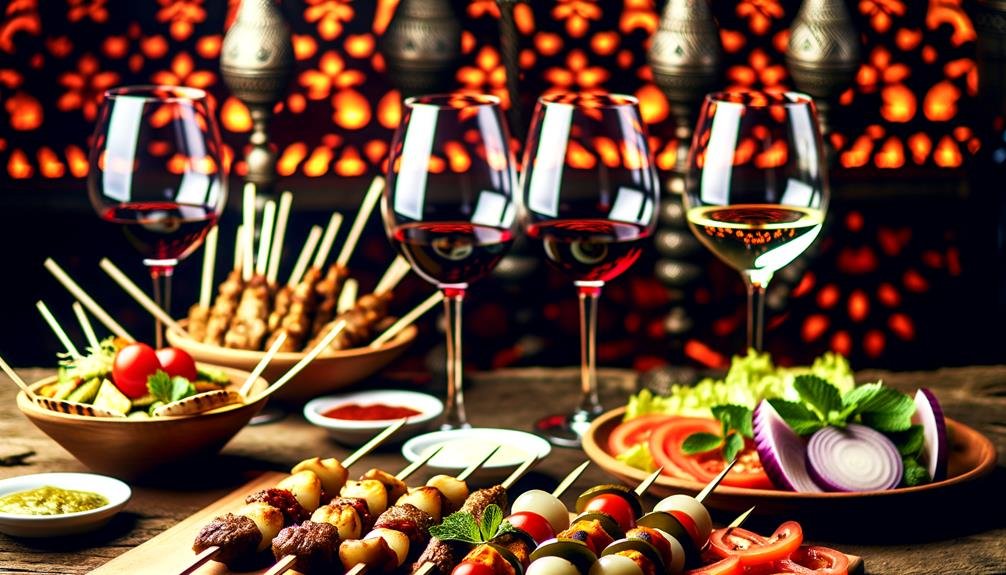
When it comes to Middle Eastern cuisine, pairing the right wine can truly enhance your dining experience. The key is to match the wine's intensity with the dish and focus on complementary flavors and aromas.
For example, dishes with raw garlic or onion are best paired with high acidity white wines. Here is a simple guide to help you pair common Middle Eastern ingredients with suitable wines:
- Parsley: Try Sauvignon Blanc or Gruner Veltliner for a perfect match.
- Onion: Sauvignon Blanc or Pinot Grigio are great choices to complement the flavors.
- Cilantro: Opt for Albarino or Verdejo for a refreshing pairing.
- Garlic: Gruner Veltliner or Sauvignon Blanc work well to balance the dish.
- Cumin: Sparkling Rose, Riesling, or Syrah are excellent choices to complement the earthy flavors.
Specific Dishes
Let's dive into wine pairings for specific Middle Eastern dishes to elevate your dining experience even more.
When enjoying crispy falafel, consider a bright Sauvignon Blanc or a vibrant Grüner Veltliner to complement its herbaceous flavors.
For grilled kebabs, a robust Syrah or a spicy Zinfandel will enhance the savory notes of lamb or beef, adding richness to the smoky profile.
Pair the creamy baba ghanoush with a crisp Assyrtiko or a mineral-driven Chablis to bring out the complex textures and flavors of this smoky eggplant dip.
These thoughtful combinations will create a harmonious blend of tastes, enriching your culinary journey.
Exploring Cuisine
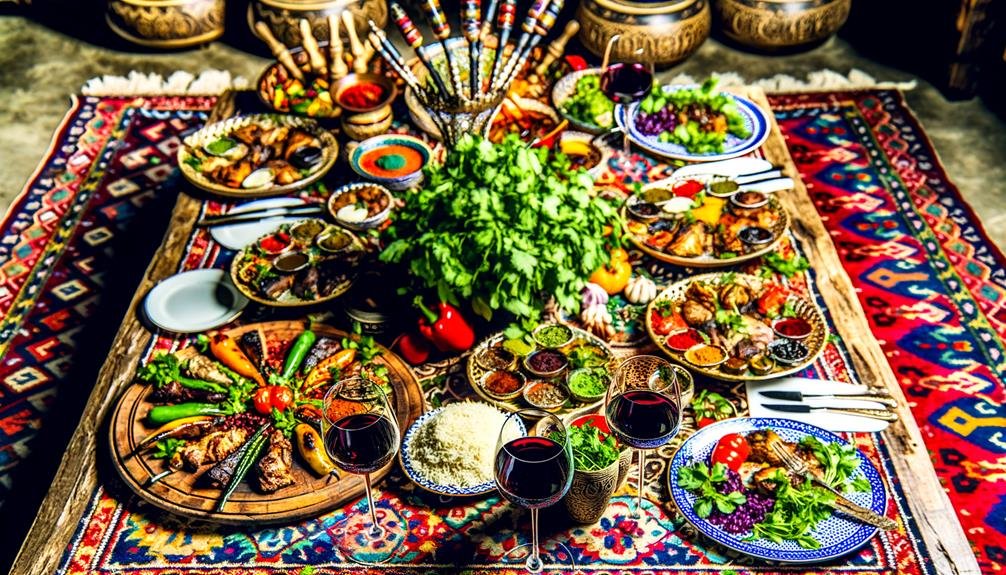
Exploring Middle Eastern cuisine introduces a world of vibrant flavors and unique culinary traditions that pair beautifully with carefully selected wines. Middle Eastern dishes are known for their rich use of herbs and spices like parsley, cumin, and cilantro, creating an opportunity for exciting wine pairings from around the world.
The combination of bold spices and fresh ingredients like lemon and garlic calls for wines with a matching intensity and acidity. For example, a Sauvignon Blanc with tangy notes can enhance the flavors of a tabbouleh salad, while a Syrah with rich, earthy tones can elevate a cumin-spiced kebab.
Wine Education
To fully enjoy the delightful combination of Middle Eastern dishes and wine, it's essential to delve into the fundamentals of wine education. By gaining a solid understanding of wine characteristics, origins, and pairing techniques, one can enhance their dining experience significantly. This knowledge empowers individuals to make well-informed decisions that complement and elevate the flavors of each dish.
Exploring wine education offers numerous advantages. Firstly, grasping concepts like acidity, tannins, and sweetness in wine helps in creating perfect matches with the diverse spices and herbs commonly found in Middle Eastern cuisine.
Additionally, delving into the origins and traditions of different wines enhances one's cultural appreciation, enriching the overall dining experience. Furthermore, embracing wine education encourages a spirit of innovation, leading to exciting and memorable culinary pairings that go beyond the conventional.
Culinary Tips
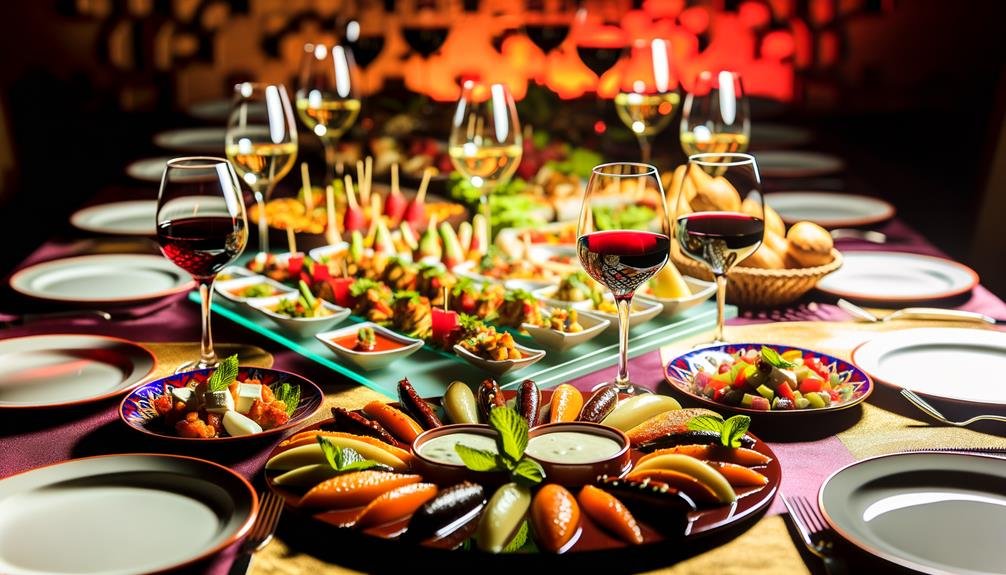
To excel in pairing Middle Eastern cuisine with wine, it is essential to grasp the delicate interplay of flavors, textures, and aromas.
When seeking unique combinations, consider the intensity of both the dish and the wine. Opt for high-acidity whites like Sauvignon Blanc to complement dishes with raw garlic or lemon notes.
Alternatively, sparkling rosé or Riesling can enhance the flavors of cumin-spiced dishes beautifully.
Crisp whites such as Albariño or Verdejo are ideal choices to accompany falafel or hummus, while bold reds like Syrah or Barbera can elevate meat dishes with rich sauces.
Pay attention to the herbs and spices used in your dish; for example, parsley pairs wonderfully with Gruner Veltliner.
Experiment with these pairings to elevate your culinary experience and uncover delightful new harmonies.
Conclusion
In conclusion, mastering wine pairing with Middle Eastern cuisine requires understanding the basic principles of flavor harmony, key ingredients, and typical dishes of this culinary tradition.
By choosing the right wines, like Sauvignon Blanc for falafel or Syrah for cumin-spiced kebabs, you can elevate your dining experience.
Visual aids, such as pairing charts, are helpful in navigating the intricacies of these combinations, offering clear guidance for a deeper appreciation of this culinary art.
